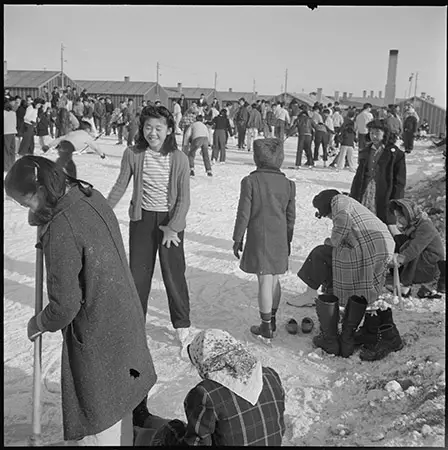Japanese Internment Camps
After Japan had bombed Pearl Harbour in December 1941, America declared war on Japan. President Roosevelt then decided to sign an order to force Japanese-Americans to leave their homes on the West Coast of America to be taken to ten different internment camps across the country.


Internment camps
Internment means putting a person in some form of prison during wartime. These camps, which were often specially built, were intended to separate certain groups of people from the rest of society in situations of war.

Why were the camps set up?
After the Japanese attack on Pearl Harbour, the American government was worried that people from a Japanese-American background might sympathise with the enemy and cause problems for the American war effort against Japan.
There was also some fear based on racial grounds. This meant that the fact that the Japanese-Americans simply looked different made many people fear them. Many members of the wider public did not trust the Japanese people to remain peaceful during the war.
Many American farmers saw the Japanese-Americans as competition and also saw the removal of this group as a way of getting full control over farming. In fact, the Japanese-Americans were peaceful and successful fruit and vegetable farmers and had not shown any signs of suspicious behaviour.
So President Roosevelt was under a lot of pressure not only from military leaders, but also the wider public to isolate the Japanese community in an act which was widely criticised.
But not all members of the public were unkind to the Japanese-Americans. A few neighbours of the farmers who had been kicked off their land let them sleep on their farms when they were homeless. Other neighbours even looked after some of the fruit farms until they returned from the camps.
Other groups were described as “enemy aliens”. Around 2,000 Germans and Italians were also seen as a threat to American security and were put into internment camps. The orders against the Japanese were harsher than these other groups though. For example, families of the Germans and Italians were not all sent to the camps and some were given a choice to join their husbands and fathers. The Japanese men, women and children were all forced to go to the camps and in much greater numbers.

What was life like in the camps for adults and children?
The camps were usually located in the middle of nowhere, guarded with watchtowers and barbed wire fencing, so that nobody could escape. Life varied in the different camps as some were harsher than others. The families lived in barracks which were wooden huts. Many people had to share small rooms, as well as eat and wash alongside everybody else.
But the families did their best to make the most of a difficult situation. The camps had schools, medical facilities and even entertainment, such as theatres. The adults were allowed to earn money mainly by working on the land to grow crops.
A large number of the Japanese-Americans in the camps were children. The children had to follow strict rules of the camp just like their parents. They went to school and did their chores. They were allowed to go outside and play, but the there were not many facilities for the children and life was often boring for them.

The closing of the camps
The camps were gradually closed between 1945 and 1946. Only some of the Japanese-Americans returned to their homes and were able to get their farms and property back. Most people left the camps with no homes, property, or even jobs to go to. Some of the farmers decided to leave farming altogether and start again.
A 1948 law was intended to return more property to the families, but it was widely seen as a failure with only a small group of Japanese-Americans gaining small amounts of compensation from the law.
It was only in 1988, that the American government finally admitted that the internment had been wrong. That year President Ronald Reagan passed an act which involved an apology from the American government, as well as the promise of twenty thousand dollars to survivors as compensation. The payments were only made by the mid-1990s after a fifty-year fight.



